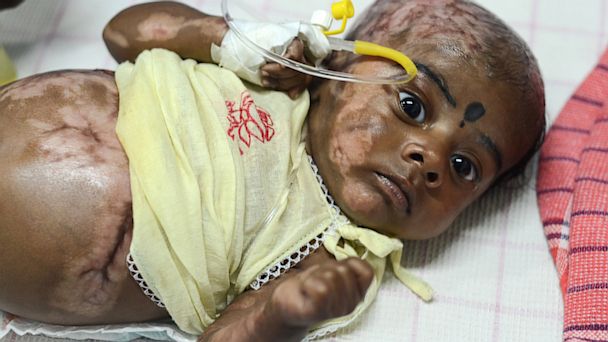Doctors Investigate Indian Baby for Spontaneous Combustion

A 3-month old infant is being examined for signs of spontaneous human combustion. (Nathan G/Barcroft Media/Landov)
A 3-month-old Indian baby is the center of a medical mystery as doctors are trying to determine if the infant suffered from spontaneous human combustion , according to the New York Times.
The infant is being treated at the Kilpauk Medical College Hospital in Chennai, India, after his parents claimed he caught on fire four separate times.
The boy's mother, Rajeshwari Karnan, said nine days after his birth she found the baby on fire in her hut after he was left alone momentarily.
"There was a flame on his belly and his right knee, and my husband rushed with a towel to put it off," Karnan told the New York Times. "I got very scared."
But that wasn't the only time it happened, according to the parents, who said there were three other similar incidents even after they took the baby to a local hospital for treatment.
Eventually the parents traveled to the Kilpauk Medical College Hospital for more extensive treatment.
Doctors there are investigating the possibility that the infant, named Rahul, has suffered from spontaneous human combustion. They have also examined the child for a host of other medical conditions, as well as possible child abuse.
Multiple medical tests have given no indication that the baby could catch fire without an ignition source, according to the Times of India.
"We are in a dilemma and haven't come to any conclusion," Dr. Narayan Babu, head of pediatrics at Kilpauk Medical Hospital, told the New York Times. "The parents have held that the child burned instantaneously without any provocation. We are carrying out numerous tests. We are not saying it is SHC until all investigations are complete."
The local media has put forward other theories about the cause for Rahul's burns. The Indian newspaper, The Hindu, pointed out that the village where the infant's mother is from had mysterious fires that burned down multiple homes in 2004.
Those fires were later found to have been caused by phosphorous cow dung that was used in building materials and had a very low ignition point.
Spontaneous human combustion remains a controversial theory as a plausible cause of death.
Experts have puzzled over the cases in which a person is found reduced to ash in their home, with the rest of the structure relatively unscathed by fire. Everything from static electricity to an errant cigarette have been theorized to cause a person to suddenly burst into flame.
Spontaneous Combustion Suspected in Death of Okla. Man
One theory is that the mysterious deaths attributed to spontaneous human combustion are actually the a result of the "wick effect." The wick-effect theory posits that a person's clothes act as a "wick" and that body fat can act as a long-burning fuel source that would eventually reduce a body to ash.
However, the "wick effect" does not account for an ignition source or accelerant.
Though many scientists remain unconvinced about the plausibility of spontaneous human combustion, the theory has gained traction in recent years. In 2011, spontaneous human combustion was declared the official cause of death for an Irish man in a controversial decision by the local courts.
"This fire was thoroughly investigated and I'm left with the conclusion that this fits into the category of spontaneous human combustion, for which there is no adequate explanation," West Galway coroner Dr. Ciaran McLoughlin told a court in September 2011.
Other scientists are still trying to discover a plausible scientific explanation for suspected cases of spontaneous human combustion.
In a 2012 article published in the New Scientist, Brian J. Ford, a research biologist, theorized that higher levels of acetone in the body could actually account for instances of spontaneous human combustion.
Read More About the Controversial Case of Spontaneous Combustion
Ford experimented with meat soaked in acetone and found that after the material burned, it resulted in a pile of ash similar to those found in cases of suspected spontaneous human combustion.
For baby Rahul, doctors remain at a loss for what is causing his condition. According to the New York Times, he will remain in the hospital for at least the next week.